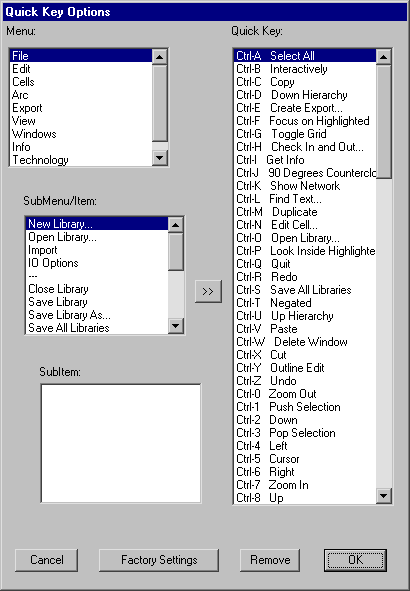1-9: The Keyboard |
1-9: The Keyboard |
|
Many common commands can be invoked by typing "quick keys" for them.
These quick keys are shown in the pulldown menus next to the item.
For example, the Negated command of the Arc menu has the quick key "Control-T".
On the Macintosh, the menu shows " To change the bindings of quick keys, use the Quick Key Options... subcommand of the User Interface command of the Info menu. The dialog shows the hierarchical structure of the pulldown menus on the left, and a list of quick keys on the right. |  |
You can remove a quick key binding with the "Remove" button, and you can add a quick key binding with the ">>" button. The "Factory Settings" button restores default quick key bindings. Use the Quick Key Options... command with caution, because it customizes your user interface, making it more difficult for other users to work at your station.
Note that the Function keys of most keyboards (F1 through F12) can also be attached to menu items. Be warned that many window systems take control of the higher function keys, and so attaching Electric commands to them may not work.
On Windows and UNIX systems, you can get to EVERY menu command with key sequences. The keys to use are underlined in the menus. For example, the File menu has the "F" underlined, and the Print... command of that menu has the "P" underlined. This means that you can hold the Alt key and type "FP" to issue the print command.
Many operations take a long time in Electric. If you grow impatient, type the interrupt key. This key varies with the different platforms:
Also, if you have pressed the mouse button but not released it yet, you will note that many operations track the effects of your intended operation on the screen. To abort this operation, type the interrupt key or the letter "a".
Electric has a highly complex command system that resides "under the surface." These commands can be invoked by typing the "-" key. However, because these commands are not intended for general use, do not type this key. If you do, a dialog will appear that will request a full command. Simply click the "Cancel" button to abort the dialog. Refer to the "Electric Internals Manual" for an explanation of the textual command language.
| Previous | Table of Contents | Next |